Unit 7: Motivation, Emotion, and Personality
7.1 Theories of Motivation
This unit is about motivation. It identifies and applies to understand behavior of humans and animals🧑🤝🧑🐻. It talks about the strengths and weaknesses between theories and the most basic primary needs: physiological, social, and sexual.
Motivational Concepts
Motivation is something that directs a behavior. For example, if you want to get a good grade on the AP Psych exam in May, you are motivated to study 💯 You're probably very familiar with motivation, but it goes deeper than you think and basically exists in every action you do.
Before going through the theories, let's discuss some vocab terms:
Insticts are behaviors that occur unconsciously because they usually just "feel right."
Incentives drive us toward or away from the behavior we want. The incentive could either be a positive stimulus or a negative stimulus, but either way, it impacts our behavior🚶
Intrinsic Motivations is when you are doing something for yourself. An example of this would be reading just because you love to read ❤📖
Extrinsic Motivations is when you are doing something for an external factor. Using the above example, if you read just to fulfill a summer assignment ✔📖, you were extrinsically motivated.
Having intrinsic motivation is stronger and drives you farther since it is something you, yourself, are genuinely interested in.
The overjustification effect is when an external factor decreases one's intrinsic motivation to complete a certain task. For example, if you began to learn French on your own time and then came across a really good job offer that requires French, you may now begin to learn French just for the job, rather than yourself💰
Achievement motivation is one theory that states our desires to master complex stuff and reach personal goals is our motivations. So even without skills, benefits or knowledge, we are motivated to challenge ourselves. Now obviously this does vary from person to person, but it is true that our motivation does drive us to do crazy stuff!
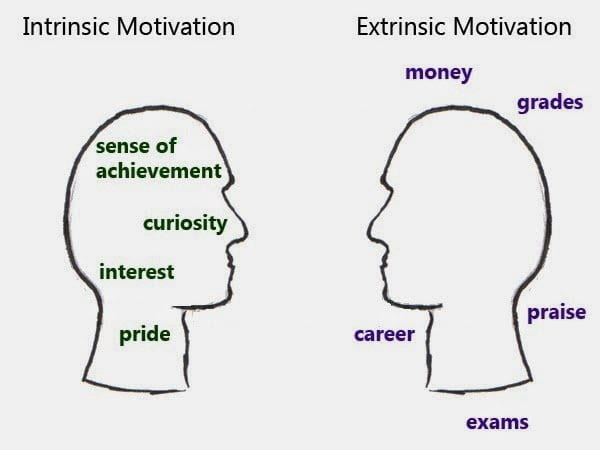 Self-Efficacy:
Self-Efficacy:
High self-efficacy is the belief that someone can complete a task successfully. This usually goes hand in hand with high and accepting challenges along the way.
Low self-efficacy is being uncertain that you can master a task and goes hand in hand with low . You don't feel as interested in learning the task, so you are unsure if you will be good at it. Having low self-efficacy leads to giving up and avoiding obstacles.
Different Theories
Many different theories about motivation developed over time. Let's discuss them!
Instinct Theory (evolutionary)
This theory has to do with Charles Darwin's principle of natural selection that stated that those that are best adapted to their environments are most likely to mate and survive. Therefore, the motivation in this theory is to survive and we, as well as animals, adapt behaviors that help us live 💕
Example | Strength of Theory 👍 | Weakness of Theory 👎 |
All babies display innate reflexes like rooting and sucking | It helps explain similarities due to our ancestral past. | It helps explain animal behaviors better than human behaviors. |
Drive-reduction Theory (biological)
This theory focuses on how our inner pushes and external pulls interact to drive our behaviors.
Push Factors: Motivate us to get away from bad things
Pull Factors: Motivate us to work toward good things
We have our need, drives, and behaviors. Our physiological needs create a tensional state that motivates an organism to satisfy that need by doing a certain behavior.
By doing this behavior, we should reach homeostasis, which is a steady internal state.
Example | Strength of Theory👍 | Weakness of Theory👎 |
When you need food, you become hungry, and then you cook yourself something to make the feeling of hunger go away. | It explains our motivation to reduce arousal by meeting basic needs, hunger, or thirst. | It doesn't explain why some motivated behaviors increase arousal |
 Optimal Arousal Theory
Optimal Arousal Theory
The optimal arousal theory focuses on finding the right level of stimulation. An organism tries to find behaviors that actually increase arousal because everything else bores them.
Example | Strength of Theory👍 | Weakness of Theory👎 |
Being bored and getting yourself into trouble just because you needed to find something to do. Another example is "Curiosity kills the cat" and you just wanna try something new that excites you! | It explains that motivated behavior may increase or decrease arousal. | It doesn't explain our motivation to address our more complex social needs. |
Yerkes-Dodson law
The Yerkes-Dodson law suggests moderate arousal can lead to optimal performance. With this being said, you've probably experienced the law in real life.
If you were ever way too relaxed 😴 when taking an exam or way too stressed 😟, I bet you noticed a decrease in your exam performance. However, if you are moderately aroused so much that you are aware and alert, you will obtain a higher score.
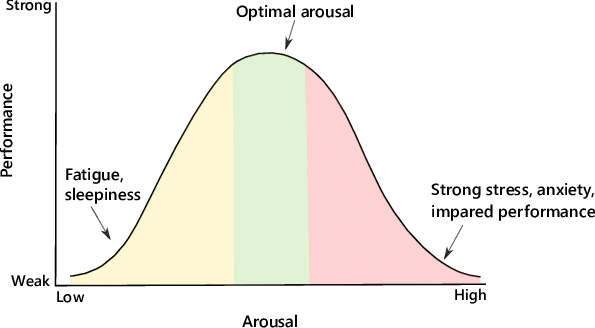 Maslow’s Hierarchy of Needs
Maslow’s Hierarchy of Needs
Maslow came up with a theory based on needs. The first level of needs focuses on fulfilling basic, physiological needs. Once they are met, the focus shifts to more cognitive and abstract needs.
From the bottom to the top, the pyramid reads:
💧🍔Physiological needs (air, food, and water)
🏠Safety (shelter, place to live)
💕Belongingness (love, a connection with someone or something)
😍Self esteem (loving yourself)
🏆Self actualization (achieving any goal you set your mind to).
Reaching self-actualization is nearly impossible. To do this, you would have to find meaning beyond yourself
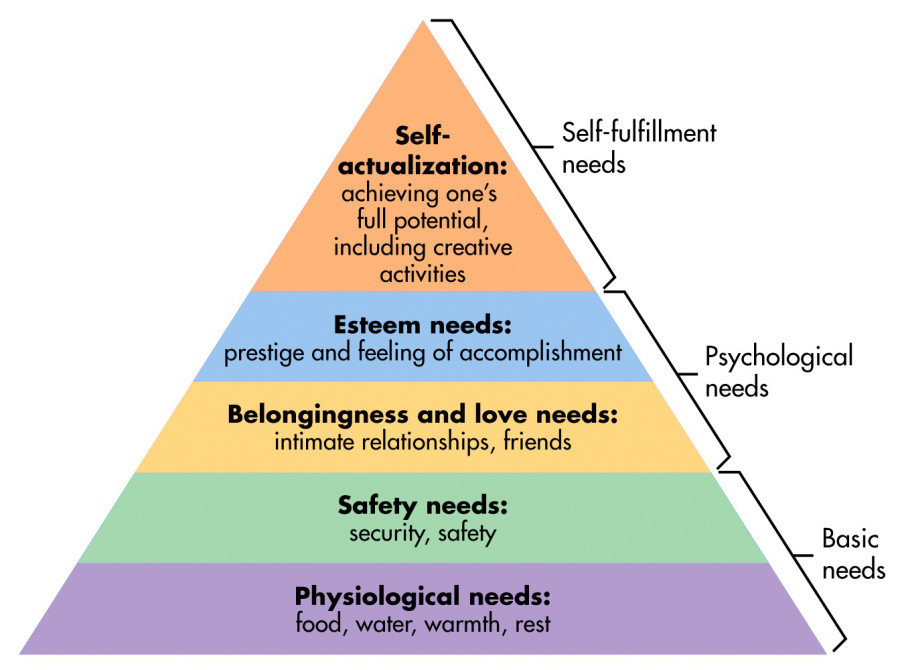
Strength of this Theory | Weakness of this Theory |
It incorporates the idea that we have levels of various needs. | The order of needs may change depending on the circumstance of the person. |
Motivations
Eating
Ever felt that huge urge to eat those Oreo late at night? Well that's a motivation of hunger, which happens simply because we need food. Or is it that simple?? Hunger motivations actually involved biological, psychological, and social factors.
Our brain plays the biggest role in hunger. The hypothalamus controls body chemistry. So when it's time for you to eat, the lateral hypothalamus activates, causing you to eat. Then you are getting pretty full from eating 5 bags of Oreos on your own. That's when the ventromedial hypothalamus kicks in, causing you to stop eating. If either part is damaged, you'll either never eat because you never feel hungry or you'll never stop eating because you don't feel satisfied. Both situations are kinda horrifying 😖.
So how does the hypothalamus decide when we need to feel hungry and full? Well the set-point theory states that the hypothalamus wants to maintain a certain body weight. So when your weight drops, it'll tell you to eat more and lower the metabolic rate, which is how quickly your body uses your energy.
But it's not solely the hypothalamus that gets to decide everything. there's also something called the Garcia effect, which states that there are certain foods that make you more hungry. If you have bad memory of eating hot dogs and throwing up, you might not feel too hungry around hot dogs as you would to Oreos. Culture and background can also play a similar effect.
Sexual Motivation
Like hunger, sexual motivations have biological and psychological properties.
The physical sexual response cycle is as follows:
initial excitement - respiration and heart rate increase
plateau phase - respiration and heart rate continue at an elevated rate
orgasm - rhythmic genital contractions, euphoria
resolution phase - respiration and heart rate return to normal
Sexual desire comes from psychological factors too. Elevation in levels of hormones or erotic material are good examples.
Social Motivation
Basically, this means you want to succeed. You want to challenge yourself and reach your goals. This is called achievement motivation. This is different from optimum arousal because it's not about only being motivated to seek, it's more about meeting a high achievement goa
7.2 Specific Topics of Motivation
We also have three specific motivations: hunger motivation🍔, sexual motivation, and social motivation🗣
Hunger Motivation
We all know our motivation of hunger too well, but let's go into the new information about it!
Washburn and Cannon, two psychologists, derived an experiment that concluded whenever we feel hungry, we experience stomach contractions. Our body, interestingly enough, keeps track of how many calories we take in and how many we burn.
Glucose circulates through the blood and provides our bodies a major source of energy.
If glucose levels decrease, our body is signaled and we become hungry. The brain triggers the hunger in the hypothalamus:
⬆Lateral hypothalamus—Stimulates hunger in a person
Produces orexin
If your lateral hypothalamus was destroyed, you would never have a will to eat.
💡 Lateral Hypothalamus = Large Hunger
⬇Ventromedial hypothalamus—Stimulates satiation (fullness) after eating
If your ventromedial hypothalamus was destroyed, you would never stop eating.
Thyroid—Regulates metabolism
Pancreas—Regulates glucose in the bloodstream
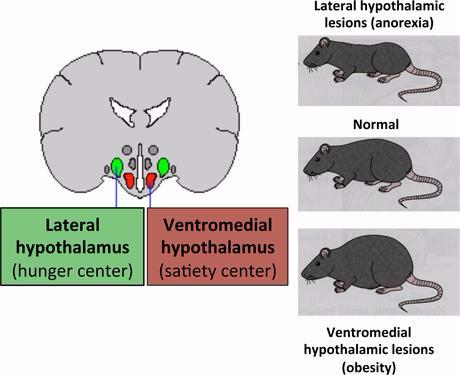
There are also lots of neurotransmitters and hormones that play a role in hunger that you should be familiar with:
⬆Ghrelin—increases hunger, secreted by an empty stomach
⬆Orexin—increases hunger, secreted by the hypothalamus
⬇PYY—decreases hunger, digestive tract hormone
⬇Leptin—decreases hunger, protein hormone secreted by fat cells
Insulin—controls glucose levels, secreted by pancreas
Set-Point Theory
Set-Point Theory states that every body has a fixed weight. When losing weight, there is increased hunger and lowered metabolism, which causes a weight rebound 🤸♀
Basal Metabolic Rate
This is a measure of how much energy our body takes in while resting and maintaining homeostasis.
Taste Preferences
Some facts to know about hunger:
When we think about whether or not we should eat, we automatically think of food. This actually, in turn, triggers hunger.
We often consume a lot of carbs when we are upset, since they boost serotonin!
As we learned in unit 4, conditioning can alter anything, including our taste preferences.
Our culture tells us what food we should eat and what food we shouldn't eat, impacting our preferences.
Neophobia, or the dislike of new foods 🤢, exists as well, and it is all because of our ancestors. Not trying new, unknown foods protected them.
Did you ever notice that you eat more when you are with your friends or family 🍏🍕🍳? This is 100% normal; when we see others eat, it makes us want to eat. Also, having different options definitely plays an impact on how hungry you get.
Sexual Motivation
Sexual Motivation seeks to describe and explain sexually motivated behavior in order to treat sexual disorders. It is a physiological need that is affected by learning and one’s values.
Zoologist Alfred Kinsey did a sexual survey in 1948, which was the first of its kind, but not that scientific. However, he found that most men and ½ of the women who participated in the survey engaged in premarital sex, which was unheard of at the time in society.
Sexual Response Cycle
Master’s & Johnson's 1960’s study about sex identified 4 stages for men and women.
Excitement—Beginning of sexual desire. Blood flows to genital region.
Plateau—Sexual desire and excitement peaks. Secretion increases.
Orgasm—Genitals contract causing ejaculation, occuring after sexual stimulation. Breathing, heart rate, and blood pressure reach their highest points.
Resolution—Body returns to an unaroused state. Males enter a refractory period, which is a resting period in which they cannot achieve orgasm again until this period is over.
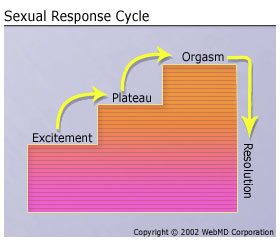
Sexual Dysfunction
Sometimes, a problem occurs that impairs ones ability to feel sexually excited. The APA classified this disorder in two ways:
A person experiences distress from unusual sexual interest
The sexual desire entails harm to other people
Hormones
Just like everything else, hormones activate sexual behavior and enable puberty in teenagers. The primary female sex hormone is estrogen, while the primary male sex hormone is testosterone. Hormones and sexual attraction go hand in hand together and always interact.
Social Motivation
Humans are generally very social beings, so we have this social affiliation need and it is one of the three basic human motivations.
Belonging
There are a few facts that you should know about feeling connected to others and close to the community you are in:
Being social boosted the chances of survival ❤of our ancestors.
If we are both social and have a sense of personal control (autonomy), we usually have a high self esteem and feel valued.
Unit 9 is all about social psychology, so you'll learn about all of this in-depth, but we often would do anything to conform to a group and gain acceptance.
Ostracism, or the pain of being excluded, exists as well. Many people reach their low when they end relationships with their close friends or partners. Children who are in the foster system also fear being alone and excluded.
Ostracism is the reason why many immigrants immigrated 🌎 as a society, rather than alone.
In our time and age, we also have social media that impacts our mental health and feeling of belonging. We always see people communicating and taking pictures together. Sometimes, we even see people hanging out just looking at their phones. Technology 💻📱 really changed our lives, but we have to be careful and monitor our social networking use.
7.3 Theories of Emotion
Emotion is a response of the whole organism involving physiological arousal ❤, expressive behaviors🚶, and conscious experience 🤔
Theories of Emotion
Just like with motivation, there are tons of different theories of emotion. What we know, in general, is that our emotions helped us survive as well. They help us stay focused at stressful times and keep us alert at cautious times🚨.
Common Sense Theory
First, there was the common sense theory that said first you feel the emotion, and then the physiological response. An example of this would be, "I'm scared so I tremble."
This was like the instinct theory in motivation; it didn't really stick and make sense to other psychologists, so they came up with their own theories after it.
💡Tl;dr—Emotion -> Physiological response
James-Lange Theory
This theory said that emotion is the result of a physiological response, which in turn activates the emotion, which is the opposite of the common sense theory.
An example of this is, "we feel sad because we cry, angry because we tense up, and afraid because we tremble.
 Cannon-Bard Theory
Cannon-Bard Theory
With this theory, a stimulus activates the brain, which simultaneously triggers physiological responses and the subjective experience of emotion. Canon believed that the body's responses are too similar to be two separate things.
An example of this is, "my heart begins pounding as I feel fear.”
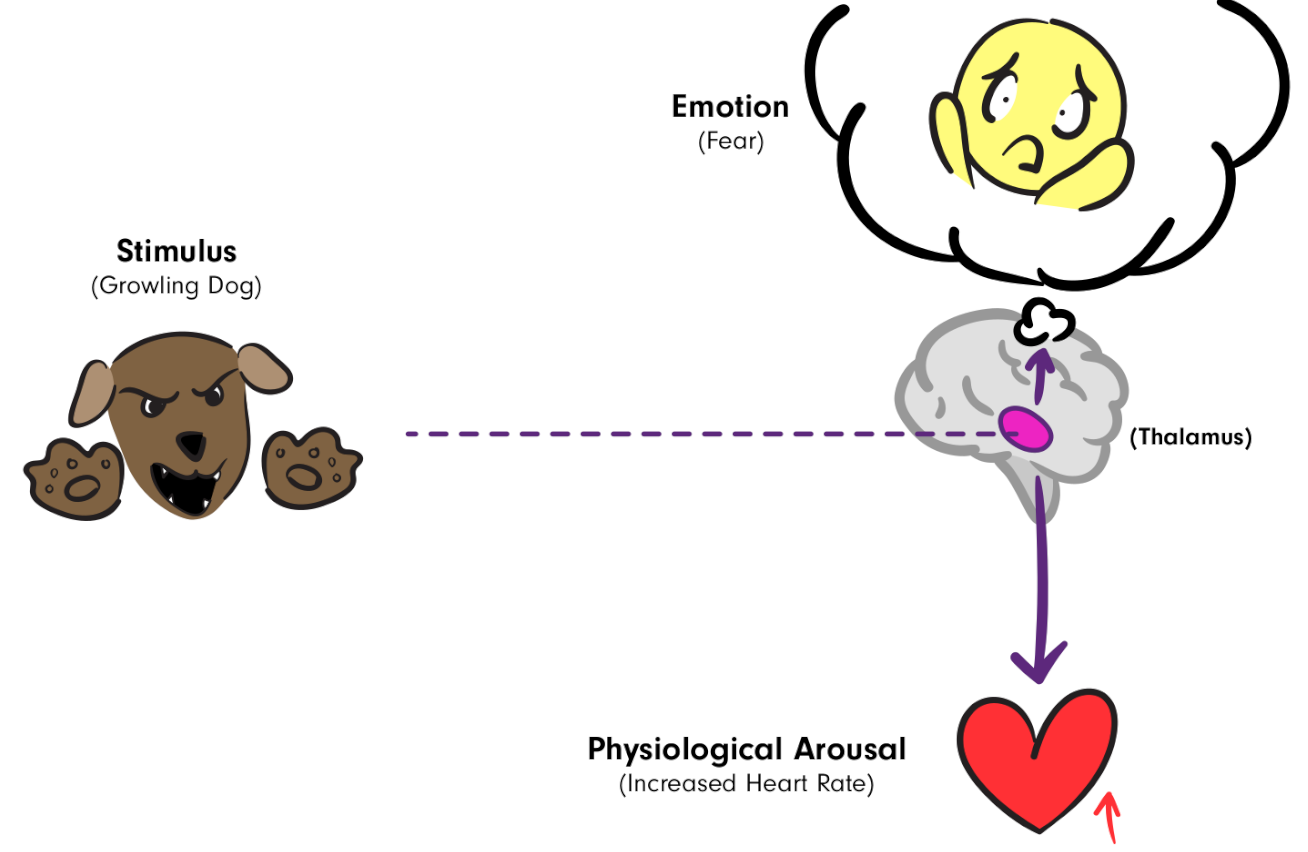 Schachter-Singer Theory
Schachter-Singer Theory
The Schachter-Singer Theory, or Schachter 2 Factor Theory, brings cognition into emotion. When one senses physiological arousal, one does a cognitive appraisal by scanning their environment in order to determine the emotion that one is feeling.
An example of this is, "I am trembling because of the snake in the room. Therefore, I must be afraid.
 Zajonc-LeDoux
Zajonc-LeDoux
Zajonc and LeDoux believed that our emotional reactions were separate from our cognitive label on the situation.
They thought that some emotions, particularly those needed for our immediate survival (e.g., anger or rage), were quickly activated through a fast pathway, while other emotions (e.g., love) went through a slow pathway. Some embodied emotions happen instantly, without conscious appraisal.
An example of this is when you automatically get startled by a sound in the forest before labeling it as a threat.
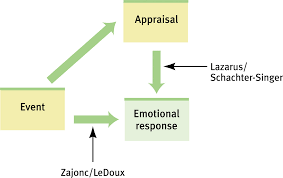 Lazarus
Lazarus
Cognitive appraisal of the environment leads us to activate physiological arousal and emotional experience.
An example of this is, “Is it dangerous or not? That sound is 'just the wind.'”
3 Primary Emotions (Evolution)
Our body's adaptive response motivates adaptive response for survival. These include fear, anger, and happiness.
Facial Expression and Emotions
Emotions are very similar, there are only subtle differences between them. They mainly differ in where the brain activates:
Fear and anger are both very similar, but fear provokes more activity💡 in our amygdala.
When we feel negative emotions, the right prefrontal cortex lights up. When we feel positive emotions, the left prefrontal cortex lights up.
Body language speaks volumes about your emotions.
We are really good at finding nonverbal threats. Angry faces, voices, and negative words tend to pop out to us.
We find it difficult to figure out who is lying. Sometimes, a polygraph is used to detect lies based on your body's physical response. Some people can mask their physical responses, so fMRIs are actually more effective when finding out who lies.
Women are better at reading emotional cues and are stereotyped as being gentle and emotional. Men, on the other hand, are stereotyped as being angry.
Culture
Research by Paul Ekman and his colleagues suggests that facial expressions are universal. No matter what, we can always detect happiness, sadness, shock, and fear on other people's faces.
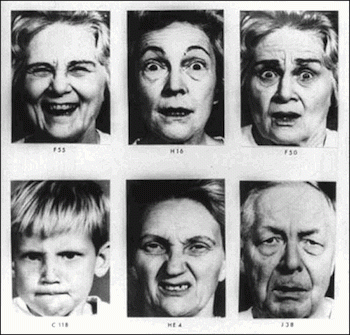 But cultures do differ in how much emotion they express. Usually, those in America and Europe seem to have more visible emotions, while those in Asia tend to hide their emotions. This is because of the individualistic culture that exists in America and Europe vs the collectivist culture that exists in Asia.
But cultures do differ in how much emotion they express. Usually, those in America and Europe seem to have more visible emotions, while those in Asia tend to hide their emotions. This is because of the individualistic culture that exists in America and Europe vs the collectivist culture that exists in Asia.
Facial Feedback Effect
The facial feedback effect is the tendency of facial muscle states to trigger corresponding feelings. For example, smiling activates muscles that directly trigger the feeling of happiness.
If you were ever really upset and just smiled at yourself, you'd notice that you cheered up a little. Smiling is a natural therapy (smile therapy😃).
7.4 Stress and Coping
Stress
Stress! We are all, unfortunately, familiar with the feeling of stress. When we experience certain events called stressors, we feel threatened or challenged, which, in turn, is stress.
When we are stressed, we could either have a physical reaction or an emotional reaction. Being stressed isn't always a negative feeling, though. If it's a short-term stressor, or a challenging one, we could easily overcome it, and it gives us a positive feeling or boost
An example of this, which you are probably familiar of, is when you are stressed for an exam. Being moderately stressed actually improves your performance (Yerkes-Dodson law), so in this case, it is a positive stress.
Stressors
There are three main stressors in our lives:
Catastrophes—unexpected events that we cannot control like floods, earthquakes, and war
Significant Life Changes—Humans don't like change, so when major events occur and life transitions take place, we feel really stressed.
Daily Hassles—If we don't take care of ourselves and manage our time, our daily schedule could cause us a lot of stress.
Stress could be very detrimental to our health, so it is important that we take care of ourselves
Responses to Stress
Fight or Flight Response
You are probably very familiar with this, but it is our stress response that involves the sympathetic nervous system and arouses us.
General Adaptation Syndrome
Psychologist Hans Selye came up with this stress response that has there phases:
🚨Alarm—Our sympathetic nervous system is activated and our body is ready to face the stressor.
🏃Resistance—We attempt to cope with the stressor. Our body is on high alert and stress hormones are released.
😴Exhaustion—We cannot be in high alert forever, so our body begins to be vulnerable.
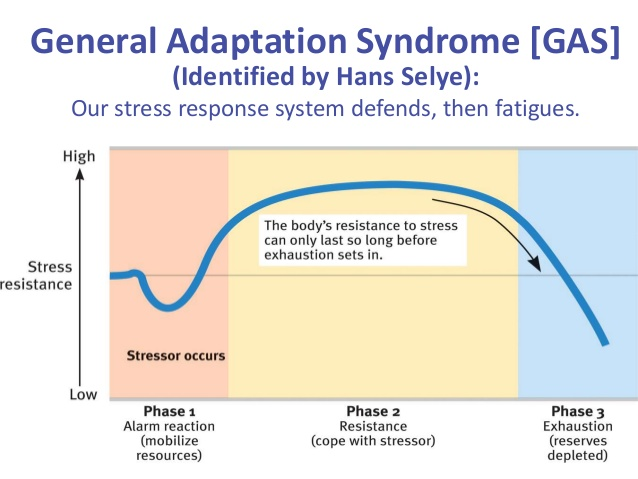 Dealing with Stress
Dealing with Stress
There are two main ways of dealing with stress:
Isolating oneself and withdrawing from society
Tend and befriend response—communicating with others and supporting others 😍 Women often do this and like to bond because of high oxytocin levels. Men usually respond more aggressively to stress.
Lewin’s Motivation Conflict theory
Lewin took fight or flight but made it more complex and created different ways people address the stress causing conflict:
👍👍Approach-approach conflict: when you have to pick between two desirable outcomes.
👎👎Avoidance-avoidance conflict: when you have to pick between two undesirable outcomes .
👍👎Approach-avoidance conflict: when one event or goal has both an attractive and undesirable outcome.
🤷Multiple approach-avoidance conflict: must choose between two or more things that have both attractive and undesirable outcomes.
Stress related illnesses
Prolonged exposure to stress can cause stress-related illnesses like heart disease, cancer, a stroke, and chronic lung disease. These could also be called psychophysiological illnesses.
Cortisol
Cortisol is a hormone associated with stress. While small amounts give benefits in the short term, prolonged exposure can cause significant health problems.
Unhealthy Behaviors
When people are stressed, sometimes they get into unhealthy behaviors, such as smoking🚬, drinking🍹, and consuming drugs.
7.5 Introduction to Personality
Research Methods Used to Investigate Personality
We went over these in unit 1, but they keep coming back since they are used to investigate everything!
Case Studies were Freud’s main source of his personality theories. He was able to study his individual patients on a case by case basis and note their differences. He was very determined to form universal truths regarding personality.
Surveys are very broad and are good to use when you want a lot of information from a large sample size. However, many surveys come with bias because not everyone responds and people could easily lie.
Personality inventories are questionnaires in which people respond to a lot of different questions that target a wide range of feelings and behaviors. These are specifically used to assess selected personality traits🧬
A key example of a personality inventory is the Minnesota Multiphasic Personality Inventory (MMPI), which is used for emotional disorders and screening purposes.
Psychologists to Know
Alfred Adler
A neo-Freudian that expanded on Freud's original psychodynamic theory with Karen Horney. They agreed that childhood was important, but social tension🗣 (rather than sexual tension) is crucial for personality development.
Adler specifically spoke about how childhood feelings of inferiority can trigger our determination for superiority and have a strong effect on personality development. He focused more on ego than the unconscious.
Albert Bandura
His major contribution to personality was the key concept of reciprocal determinism, how a person’s personality can change based on the situation or people they are around.
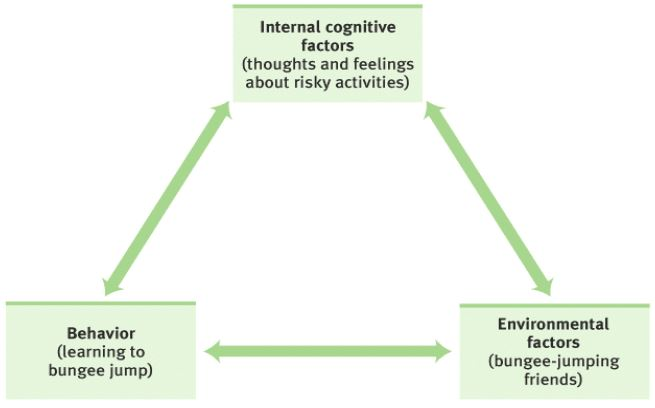 Paul Costa & Robert McCrae
Paul Costa & Robert McCrae
They came up with the big 5 factor trait, a theory that there are 5 major factors (personality traits):
🧠Openness: open to new experiences, related to ones creativity, flexible thinking
📅Conscientiousness: dimensions of hard work, responsibility, and organization
💭Agreeableness: easy to get along with others, shows empathy
🗣Extroversion: Outgoingness; a shy person would have low extraversion
😰Neuroticism: emotional stability; people with high neuroticism might be nervous, depressed, or anxious
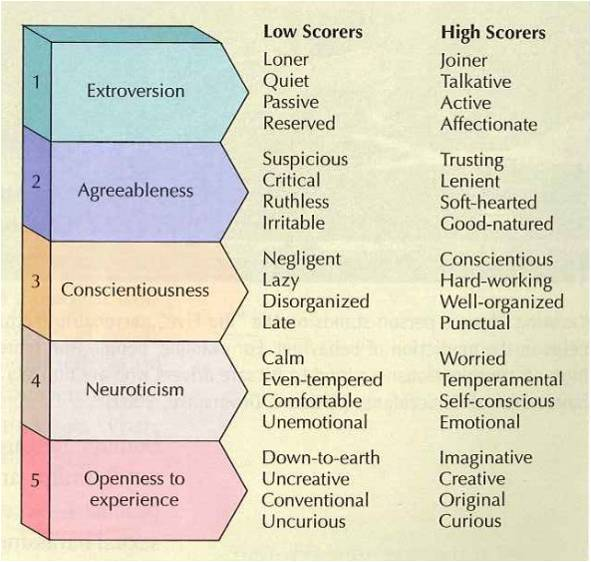 Sigmeund Freud
Sigmeund Freud
Freud believed that one’s personality was essentially set in early childhood. As the child passes through 5 psychosexual stages, their personality develops. It's during these 5 stages that the 3 parts that make up our personality (the id (devil), ego (angel), and superego (referee)) are formed, as well.
Oral: (birth to 1 year) pleasure is found in the mouth
Anal: (1 to 3 years) control of bowel movements
Phallic: (3 to 5 years) noticing the difference between being a boy and a girl (sex organs)
Latent: (6 to puberty) repress sexual feelings and concentrate on social and academic skills
Genital: (adulthood) guided by sexual gratification through relationships
Carl Jung
A neo-Freudian who took Freud's theory of personality and expanded on it. Jung believed that an individual's personal unconscious contains the painful or threatening memories and thoughts the person does not want to confront.
He contrasted the personal unconscious with the collective unconscious. This collective unconscious contains archetypes that Jung defined as universal concepts.
Abraham Maslow
Maslow is the humanistic psychologist that created the hierarchy of needs. He believes people are motivated to achieve self actualization by working their way up through this hierarchy
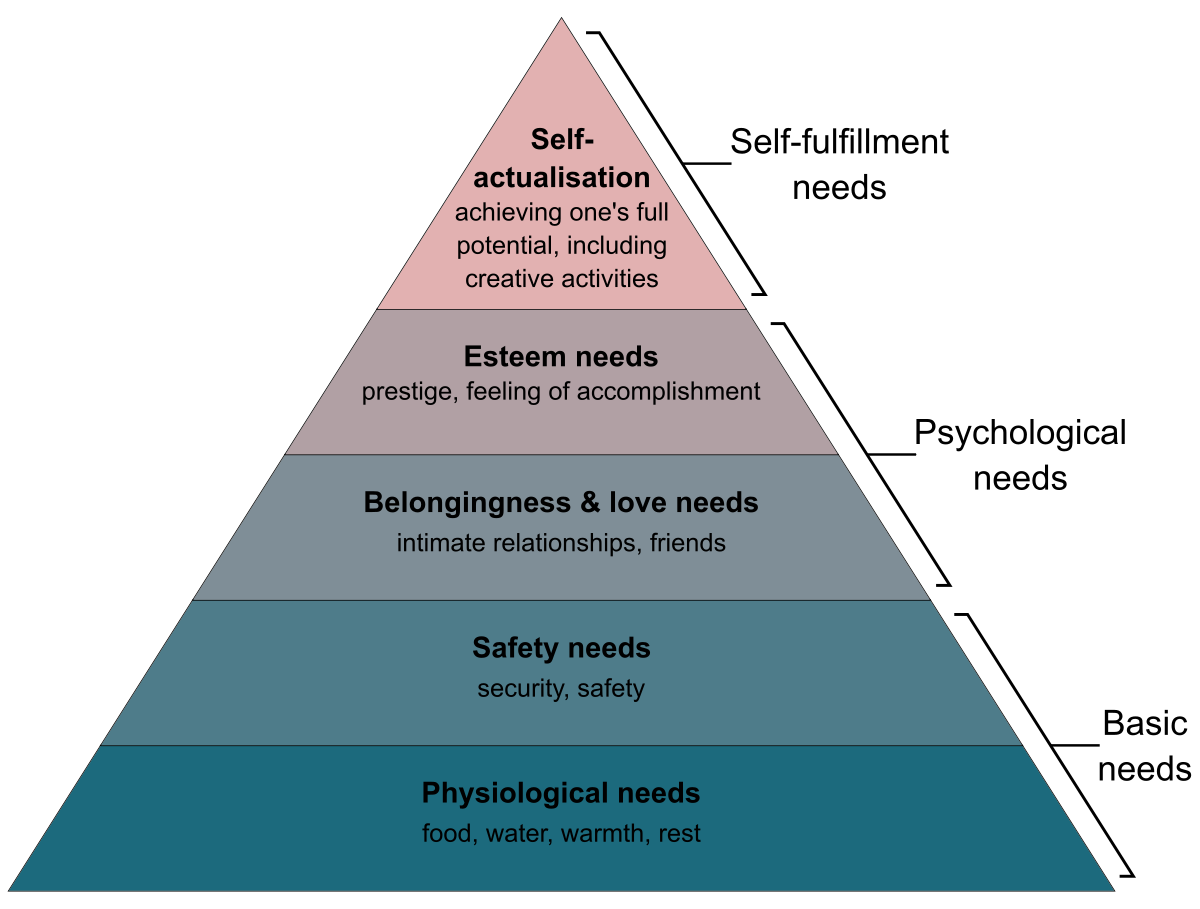 Humanists believe that a positive self-concept equals high self-esteem and when people achieve self actualization, their personalities change .
Humanists believe that a positive self-concept equals high self-esteem and when people achieve self actualization, their personalities change .
Carl Rogers
Rogers is another humanistic psychologist that believes free-will will lead to self actualization. As long as you have one person in your life that will give you unconditional positive regard, you can reach self actualization.
Acceptance is key (unconditional positive regard); however, humanists only look at the innate good and best in people, and ignore the negative. Self actualization equals a self accepting personality
📝 Key Vocabulary
Personality inventories | MMPI | Personality | Free association |
Psychoanalysis | Unconscious | Id | Ego |
Superego | Psychosexual Stages | Oedipus complex | Identification |
Fixation | Defense Mechanisms | Self-serving bias | Narcissism |
Individualism | Collectivism | Psychodynamic theories | Collective unconscious |
Projective Tests | TAT | Inkblot tests | False consensus effect |
Positive psychology | Spotlight effect | Self-esteem | Self-efficacy |
Humanistic Theories | Self-actualization | Unconditional Positive Regard | Self-concept |
Trait | Factor Analysis | The big 5 | Reciprocal Determinism |
7.6 Psychoanalytic Theories of Personality
Psychoanalytic Theories
Psychoanalytic theories look at the influence the unconscious has on personality. They are completely based on Freud's theory of personality.
Psychoanalysis used free association to explore an individual's unconscious 🧠 This is where the person relaxes and says whatever comes to their mind, no matter how crazy or unreasonable it is. Freud thought that eventually, something the person would say out loud would trigger thoughts in the unconscious⛓
The Unconscious
Freud believed that much of people's behavior is controlled by a region of the brain he called the unconscious. The unconscious stores all of the unacceptable thoughts and desires, which are sometimes repressed.
The preconscious is where our other thoughts live, and they can easily be accessed and brought to the conscious mind.
The conscious has all of the thoughts that we are aware of and express.
Freud also split personality based on three different parts:
🤫Id—The id is the storage of unconscious thoughts and these thoughts are all directed toward fulfilling sexual and aggressive drives. The id operates on the pleasure principle that wants automatic gratification.
💡Built by our sexual and aggressive needs
⚖Ego—The ego is between the id and the superego and it operates on the reality principle. It tries to satisfy what the id wants, but without the immediate gratification portion. Usually, because of the ego, needs are fulfilled in the long-run.
💡Think of the ego as the decision maker and the balance between the id and superego.
💯Superego—The superego is basically our conscience. It tries to make us conform to and thrive in society. If the id pushed us to do something bad, the superego would, in turn, make us feel guilty because the behavior wasn't morally correct.
💡Built by our parents and society
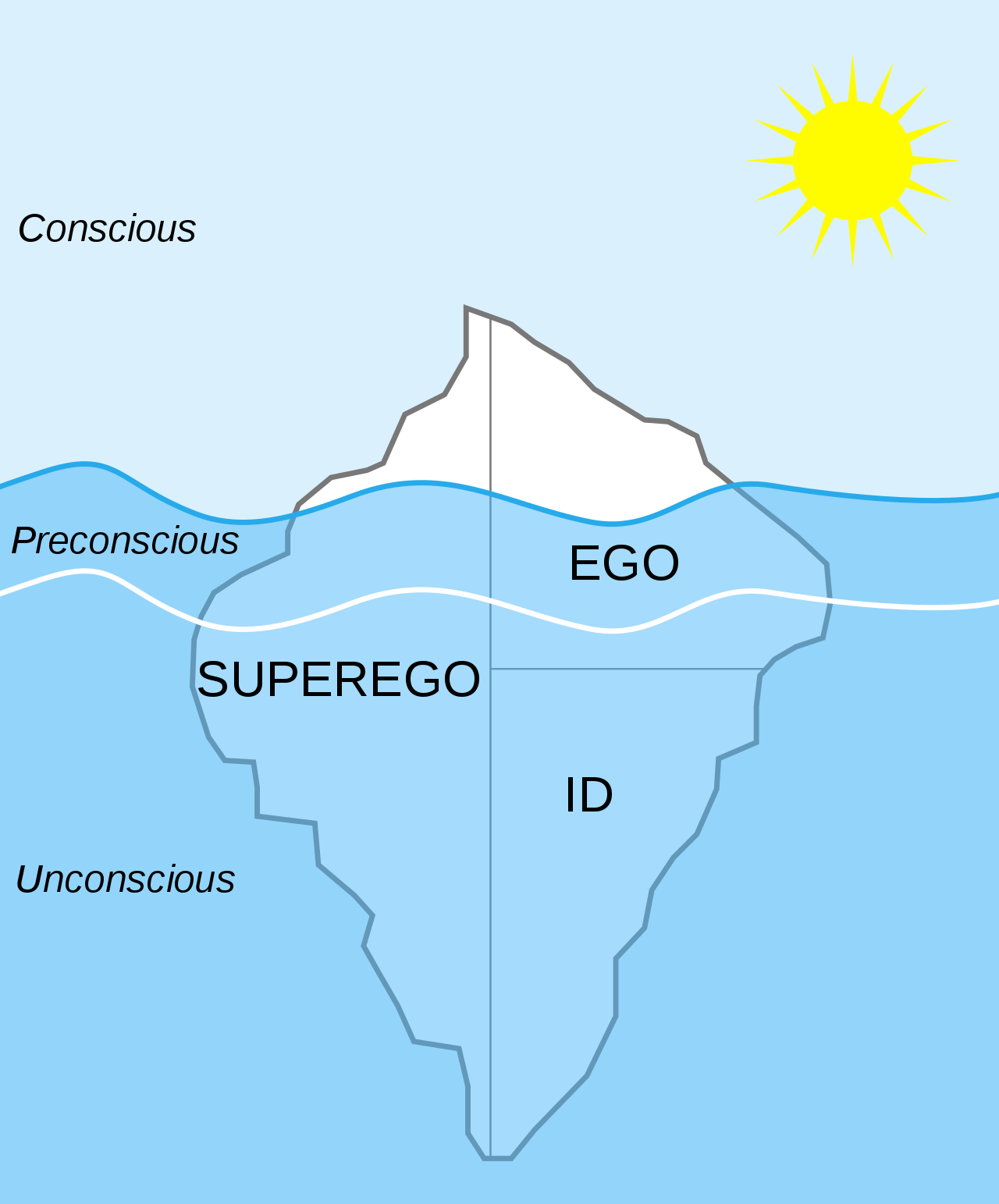 Psychosexual Stages
Psychosexual Stages
Freud also believed that one’s personality was essentially set in early childhood and proposed that as we grow, we move from one psychosexual stage to another. These are childhood stages of developments that he created. Remember, Freud didn't have much research to back his theories up; he only really did case studies, which usually cannot be generalized to the whole population.
These childhood stages of development were all about how the id focused on specific pleasurable zones.
These include:
Oral—pleasure focused on the mouth (sucking, biting, chewing)
Oral fixation—where the oral stage goes beyond the age of 1. Some examples are smoking, nail-biting, and gum-chewing.
Anal—pleasure focused on the bowel (potty training) 🚽
Anal Retentive—similar to oral fixation. Someone that is anal retentive focuses on being neat and organized. Extreme attention to detail.
Anal Expulsive—opposite of anal retentive. Person is usually disorganized, careless, and has some sort of artistic ability.
Phallic—pleasure focused on the genitals
Includes the oedipus complex, which is where young boys feel attracted to their mother and feel jealousy toward their father. There is also the electra complex, where young girls feel attracted to their father and jealousy toward their mother.
Latency—no sexual feelings
Genital—relationships and mature sexual experiences
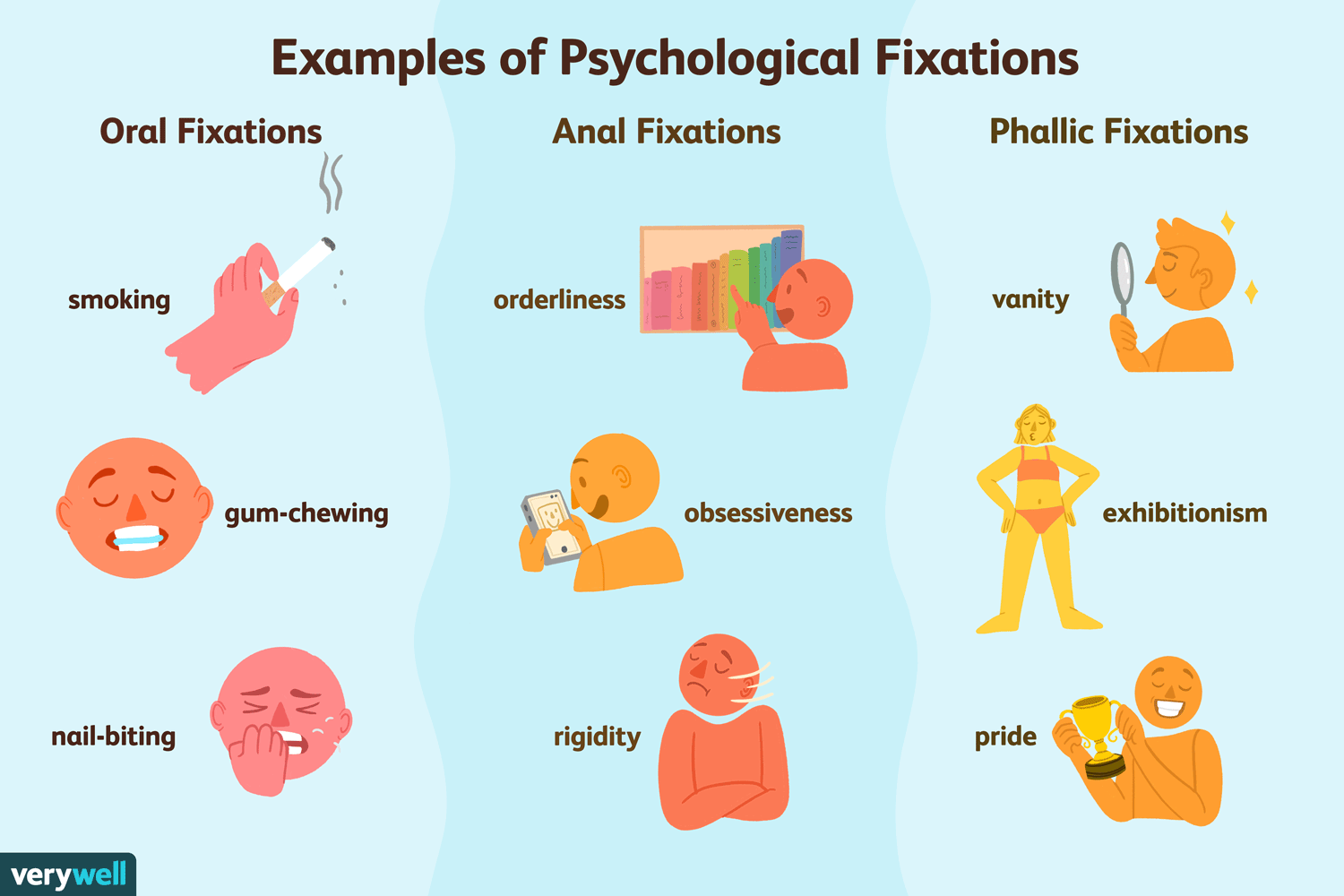 After feeling threatened by the mother or father because of the oedipus complex/electra complex, usually identification occurs. This is where the child wants to be like that mother or father figure and adapt their traits. It only happens with the opposing sex parent and this is how, according to Freud, children coped with the feelings they felt during the phallic stage.
After feeling threatened by the mother or father because of the oedipus complex/electra complex, usually identification occurs. This is where the child wants to be like that mother or father figure and adapt their traits. It only happens with the opposing sex parent and this is how, according to Freud, children coped with the feelings they felt during the phallic stage.
⭐️
The parent becomes a role model.
Defense Mechanisms
Whenever the ego feels threatened by an action, it enlists a defense mechanism to rationalize behavior. There are several types you should know:
📌Repression—Gets rid of the cause of anxiety
👶Regression—Acting like a younger age when anxiety was not experienced.
An example is if a child sucked their thumb on the first day of school.
😡Reaction Formation—Expressing the exact opposite emotion of what one feels.
An example would be being angry but acting really kind in front of your friends.
🤦Projection—Taking how one feels and placing it on someone else
An example would be cheating on an exam and accusing your innocent classmate of cheating.
🍺Rationalization—Making excuses for one's situation or cause of anxiety
An example is that someone who drinks might put their drinking addiction on their friends saying they are just "socializing."
↔Displacement—Changing the target of one's aggression
An example is if a child was mad at their parent, they might kick their dog 🐶
Sublimation—Rechanneling emotions into a socially acceptable activity.
An example would be an aggressive person turning that aggression into passion and become a surgeon.
❌Denial—Refusing to believe an idea that causes anxiety
An example how smokers may refuse to admit that smoking is bad for their health.
🧠Intellectualization—Obtaining knowledge over something as a means of having a sense of control.
An example is if a person suffers a tragedy, they would try and seek counseling and identify with others going through the same thing.
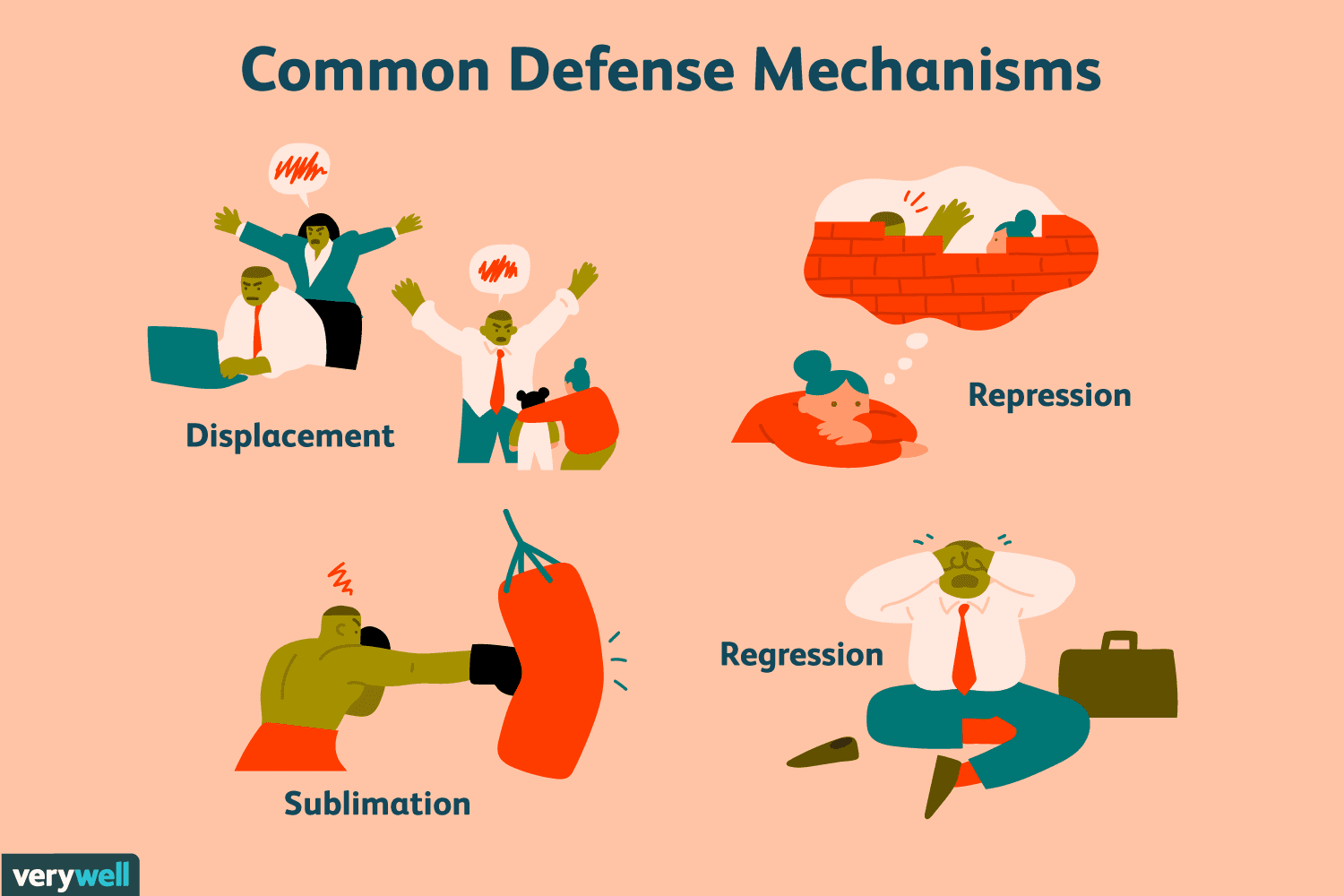 Criticisms of Freud
Criticisms of Freud
His findings are not really scientific; there is no empirical evidence. 🧪
He overestimates the importance of early childhood and of sex. Psychologists today believe that we develop over a longer period of time, past our childhood.
Little predictive power!
Some psychologists, like Karen Horney and Nancy Chodorow, felt that Freud’s theories seemed chauvinistic.
Today, psychologists agree with some of the defense mechanisms.
Impacts of Freud
Though it has its shortcomings, the Freudian theory has made tremendous impacts. Many people know that our unconscious thoughts shape our behavior. It has also made an impact on art (!!). Salvador Dali's paintings dept the Freudian unconscious, while Woody Allen's films feature a lot of characters going through psychoanalysis.
Psychodynamic Theory
Neo-Freudian psychologists were followers of Freud who took his ideas about the unconscious and expanded on them in a way that did not please Freud. They accepted the id, ego, and superego, the defense mechanisms, and the importance of the unconscious. Neo-Freudian psychologists emphasized social interactions more than sex.
Carl Jung
Jung agreed that the unconscious plays a large role in our development, but he thought it was more than just repressed thoughts. He proposed it consists of two different parts:
Personal Unconscious—consists of painful memories and thoughts a person doesn't want to confront.
Collective Unconscious—passed down through a species, inherited universal concepts that we all share as humans. These concepts are called archetypes.
Alfred Adler
He focused on the conscious role of the ego more than the unconscious. He believed that motivation comes from fear of failure, the inferiority complex, and the desire to achieve. He also thought about the superiority complex where people mask their fears of being inferior by acting superior.
He thought that we wanted to prove ourselves.
7.7 Behaviorism and Social Cognitive Theories of Personality
Social-Cognitive Theories
Social Cognitive Theories emphasize the way personalities influence and are influenced by our interactions with our environment. They elaborate on how personalities are affected by principles of learning 📚, cognition, and social behavior 🗣
personal-construct theory: people develop their own system of constructs in order to better understand the world
fundamental postulate: people's behavior is influenced by their thinking, so we can easily predict what they will do in the future by knowing what they did in the past
Reciprocal Determinism
Albert Bandura, who is also known for the social learning theory in unit 4, came up with this idea of reciprocal determinism. He found that children modeled the behaviors of the adults, even if it meant hitting a Bobo doll. You could see the influence of the Bobo doll experiment in his personality theory; it features imitation and modeling 🦆
Bandura believed that personality can change depending on one's thoughts, the environment, and behavior. It's a three way system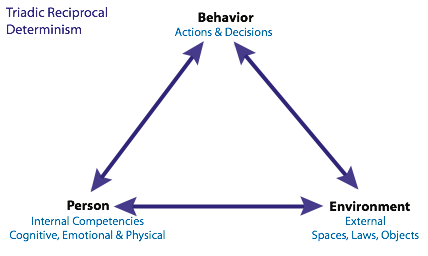 Locus of Control
Locus of Control
Do you control fate or does fate control you? There are two different loci of control:
An internal locus of control is where you believe you 👤 can control fate and what happens in your life. Having an internal locus of control is healthier because you actually take control of what happens to you and you can make choices 🧠
An external locus of control is where you believe the world determines what happens to you and there is no way you could change it. You have no choice but to live the way fate "wants" you to.
Learned Helplessness
Learned Helplessness is a state in which an organism has learned to resign itself to repeated aversive events as they believe that they have no control over their lives. They feel helpless, hopeless, and depressed. This goes hand in hand with an external locus of control.
It's one of the underlying causes of depression. An example is if a lifelong smoker 🚬 tries to quit repeatedly and fails every time. They just end up feeling hopeless and at some point, they might give up.
Optimism vs Pessimism
You could either lead your life with an optimistic 😊 outlook or pessimistic outlook 😔 Social-cognitive psychologists always emphasized our sense of personal control, which directly impacts how we lead our lives 🧗
Those that have a sense of personal control usually lead life with an optimistic outlook because they know they could make changes in their lives. Those that don't have a sense of control usually think pessimistically and believe there is no way to change their lives.
People with an optimistic personality always look on the positive side of things. Their personality seems to be uplifting and people love to be around them, while in contrast, a pessimistic personality always seems to look at the negative.
Each has its good points and its bad and success usually comes with a balance between the two. Someone should be optimistic enough to remain hopeful but pessimistic enough to know the extent to which they can succeed 🏆
An Individual
You, yourself, are an organizer of thoughts, desires, emotion, and personality.
Self-Esteem
Your self-esteem is how much you value yourself. If someone has a high self-esteem, they feel confident and able to reach their goals. With a low self-esteem, it is hard to get anywhere, as some don't feel comfortable in their own skin.
Self-Efficacy
Self-efficacy refers to your ability to have confidence in completing a task. Believe in yourself, you can do anything you set your mind to!
Individuals that have a high self-esteem and self-efficacy feel really good about themselves, sleep better, tend to be less anxious, are persistent, understand their self-worth, and put themselves up to challenges
Self-Serving Bias
This is where most people are likely to perceive themselves favorably. An example of this would be accepting when good things happen and attributing it to their hard work and dedication, while rejecting when bad things happen and blaming it on others.
This occurs a lot in school, and maybe you've experienced it. If you've gotten a good grade on a test 💯, you probably were really proud of yourself and attributed it to your studying and hard work. However, if you got a bad grade, you'd blame the teacher and how hard the exam was.
Positive Psychology
There is a realm in psychology that deals with a positive well-being, positive health, and positive education. It is mainly studied by someone called Martin Seligman, and he aims to help individuals thrive.
Behavioral Theories
Behavioral theories focus more on the effect of learning 📚 on our personalities. This brings back unit 4 and conditioning; we are conditioned to repeat effective behaviors and continue to learn from the environment around us.
There isn't much about behavior and personality but you should understand that conditioning can influence our personality and the way we live our lives everyday.
Skinner argued that personality is determined by environment. According to this behaviorist thinking, we would be able to change one's personality simply by changing one's environment. This, however, has obvious shortcomings as it doesn't really take into account cognition.
7.8 Humanistic Theories of Personality
Humanistic Theories of Personality
Humanistic theories of personality view people as innately good 👍 and able to determine their own destinies through the exercise of free will. They focus on the importance of:
Self-esteem: a person’s feeling about oneself. Do they like what they see in the mirror? 🤳
Self-esteem is explored more in the last key topic.
Self-concept: a person's global feeling about themself. "Who am I?" 👤
If someone has a positive self-concept, they perceive the world through an optimistic (positive) lens.
If someone has a negative self-concept, they feel unsatisfied.
⭐⭐Whether or not your self-concept is positive depends on how closely you match yourself with your ideal self, or the person you want to be.
Self-concept is a central component of humanistic theories of personality.
Abraham Maslow
Maslow created the Hierarchy of Needs that describes motivation and the way to reach self-actualization. One must fulfill their physiological needs first 🥐, then safety needs 🏠, then the need of feeling loved 💖, then feeling accomplished 🏆, and finally, self-actualization.
You need to go past all these stages in order to be self-actualized, since you must feel accomplished and have the ability to do anything first. Self-actualization is when you fill your potential. When you find a purpose beyond yourself and are able to help others around you, you also reach self-transcendence
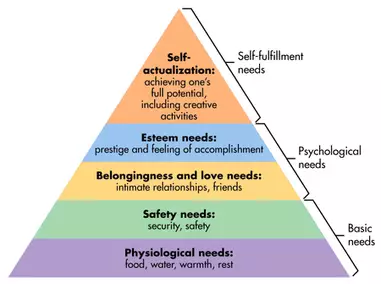 Both Maslow and Rogers believe that people are motivated to reach their full potential.
Both Maslow and Rogers believe that people are motivated to reach their full potential.
Carl Rogers agreed that people are innately good, but he thought they require certain things from their interactions with others. He believed in a growth-promoting environments 🌍 that include:
Genuineness—When people are genuine, they are transparent with their feelings.
Acceptance—Unconditional Positive Regard
Empathy—When people are empathic and show they share the same feelings, others feel comfortable and continue explaining how they feel.
All three of these make for an unconditional positive regard, which is when people are treated with complete acceptance regardless of their flaws.
Humanistic psychologists believe that in order to reach self-actualization🌱, they must be given this atmosphere of acceptance and kindness.
Criticisms of These Theories
Many believe that these theories are overly optimistic, only looking at the good in people and ignoring the bad. They are also too self-centered, vague, and subjective.
Self-Concept and Culture
As we went over briefly before, culture has a huge impact on who we are and how we fit into society. There are two different types of cultures:
🙋Individualistic cultures focus more on the individual, privacy, and personal achievements.
👪Collectivist cultures focus on community and priority to the group.
If you were born in an individualistic society, self-esteem and self-concept are tied to your individual achievements and what you accomplish. If you didn't reach a certain goal, you'd have a low self-esteem and self-efficacy, thinking you don't have the ability to do it. Because of this, individualistic cultures have a higher rate of stress-related disease; we are constantly stressed, trying to make it in this world.
If you were born in a collectivist society, self-esteem and self-concept are tied to your family and your position in a group. Rather than individual goals, how much you contribute to the group affects your self-esteem and self-efficacy. If you didn't do much to help your group, you may feel stressed. Collectivist societies are generally less stressed because they have their group to fall back on.
Concept | Individualism | Collectivism |
Self | Independent (identity from individual traits) | Interdependent (identity from belonging) |
Life task | Discover and express one's uniqueness | Maintain connections, fit in, perform role in the group |
What matters | Me—personal achievement and fulfillment; rights and liberties; self-esteem | Us—group goals and solidarity; social responsibilities and relationships; family duty |
Coping method | Change reality | Accommodate to reality |
Morality | Defined by individuals (self-based) | Defined by social networks (duty-based) |
Relationships | Many—often temporary or casual; confrontation is acceptable | Few—close and enduring; harmony is valued |
Attributing behaviors | Behavior reflects one's personality and attitudes | Behavior reflects social norms and roles |
7.9 Trait Theories of Personality
Trait Theorists
Trait theorists believe that we can describe people's personalities by specifying their main characteristics 😎 These characteristics are thought to be stable and to motivate behavior with the specific trait. Trait theorists are most likely to claim that personality is genetic 🧬
Gordon Allport
Allport was the one that first described personality through traits, which are patterns of behavior.
cardinal traits - defining characteristic
central traits - general characteristics that form behavior
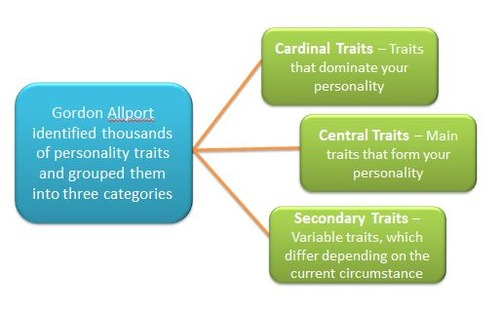 Factor analysis from the intelligence unit, comes back here. It is a procedure used to find clusters of traits that are similar and make up your personality.
Factor analysis from the intelligence unit, comes back here. It is a procedure used to find clusters of traits that are similar and make up your personality.
Every personality test that you take online is a trait personality test, and there are so many different types.
Hans Eysenck
Hans Eysenck is one who believes in the nomothetic approach: the belief that the same basic set of traits can be used to describe all people’s personalities 🌎He believed that by classifying all people along an introversion-extraversion scale and a stable-unstable scale, we could easily describe their personalities. Three dimensions played a key role: extroversion, neuroticism, and psychoticism. Extroversion means sociability and ability to pay attention to outside world and environment. Neuroticism measures our level of instability and psychoticism measures our level of tough-mindedness.
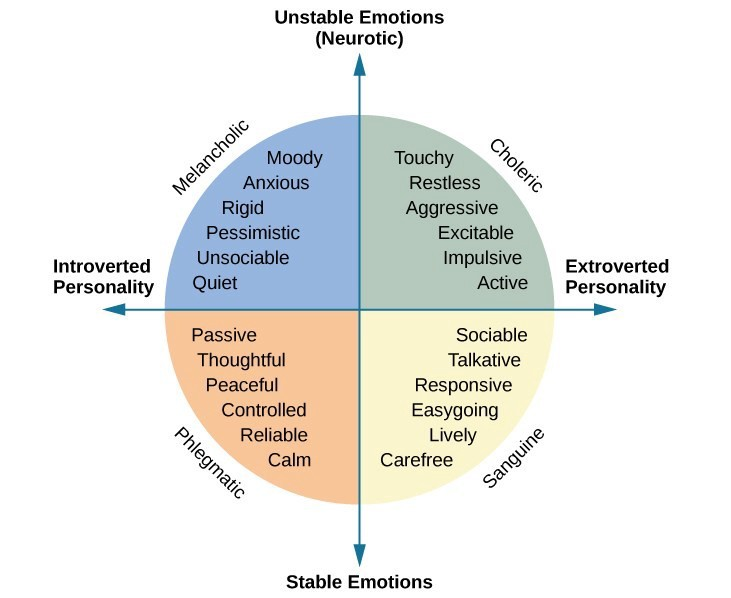
Isabel Myers and Katharine Briggs
You could probably identify the type of personality test they created by their last names: the Myers-Brigg Type Indicator (MBTI). They mostly studied surface traits and source traits, which are visible areas of personality and underlying personality characteristics, respectively. It is used all around the world and there are four main sections of the test:
Favorite world
😊Extroverted—outgoing, energetic, sociable. Do you find yourself more attached to communicating with others?
🎨Introverted—gentle, quiet, caring, logical. Do you find yourself focused on yourself and being alone?
Information
🔰Sensing—organized, observant. Do you focus more on what is given to you?
🤔Intuition (N)—logical, conceptual, insightful. Do you interpret and add meaning to the information that is given to you?
Decisions
❤Feeling type—sensitive, appreciative, tactful. Do you put more weight on personal concerns?
⚖Thinking type—are good at analyzing pros and cons and are logical. Do you put more weight on facts and objective?
Structure
💭Judging—determined, concrete. Do you stay to what you know?
🔎Perceiving—independent, questioning, adaptable. Do you stay open to new things?
You don't really have to know the specifics, but it's really interesting to fit yourself into each category. Here's the link if you want to take the test and see if you guessed correctly. Have some fun with what you learn!
This information was adapted from the Myers-Brigg Website.
Here is a diagram of the different personality types that come from these four traits:
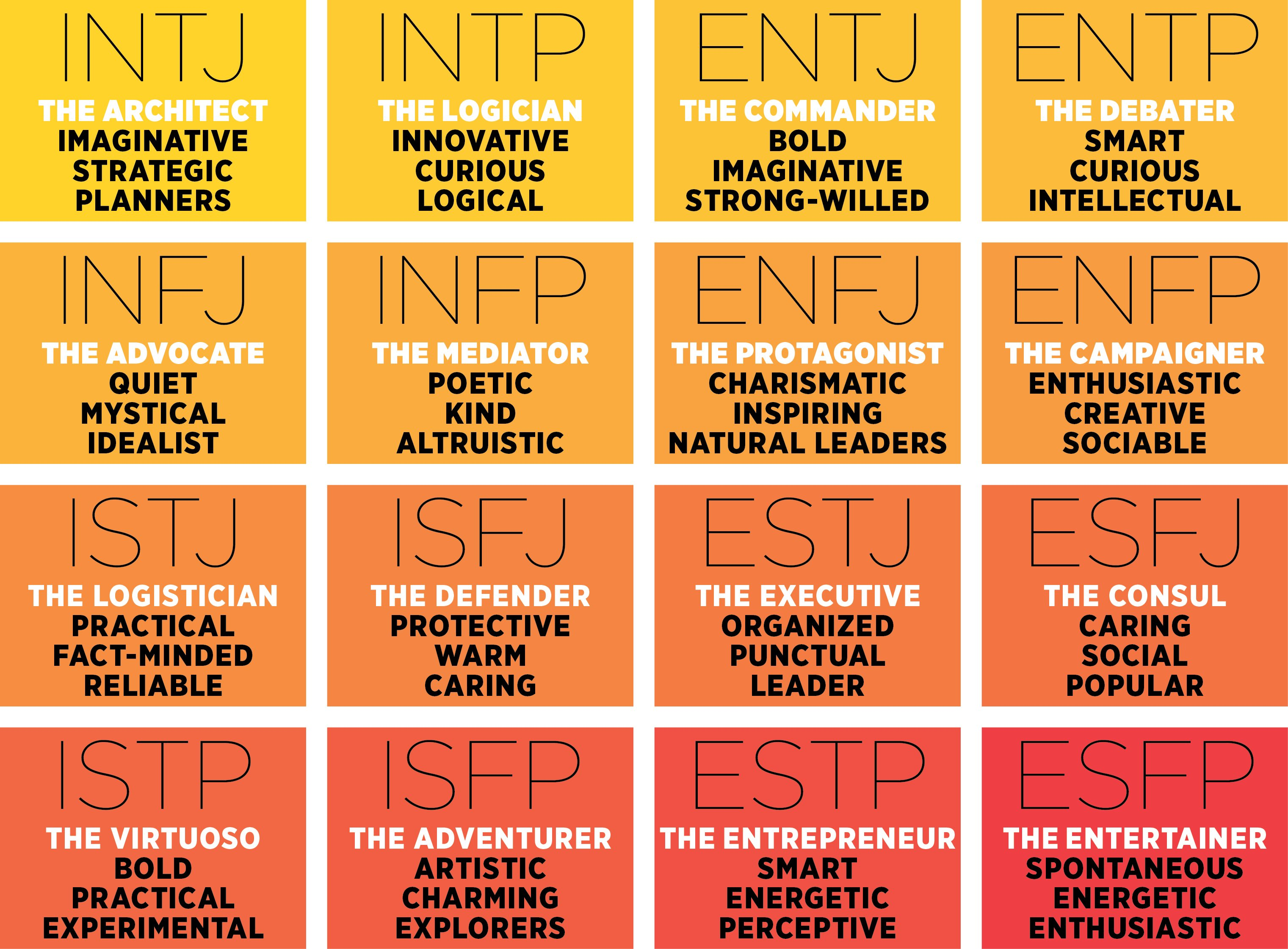 Raymond Cattell
Raymond Cattell
Cattell created the 16 PF (personality factor) which measures what he believed were the 16 basic traits present in all people, but to different degrees. It is unlikely that you have to know the 16 factors.
Paul Costa and Robert McCrea
Paul Costa & Robert McCrea proposed that personality can be described using the big five personality traits:
📆Openness—Do you like change? Can you adapt to it?
Low score: practical, prefers routine, comforting
High score: imaginative, prefers variety, independent
🧮Consciousness—Are you organized and careful?
Low score: disorganized, careless, impulsive
High score: organized, careful, disciplined
😊Agreeableness—How well do you get along with others?
Low score: ruthless, suspicious, uncooperative
High score: soft-hearted, trusting, helpful
🗣Extroversion—Are you shy or outgoing?
Low score: retiring, sober, reserved
High score: sociable, affectionate, fun-loving
😬Neuroticism—Are you anxious often?
Low score: calm, secure, self-satisfied
High score: anxious, insecure, self-pitying
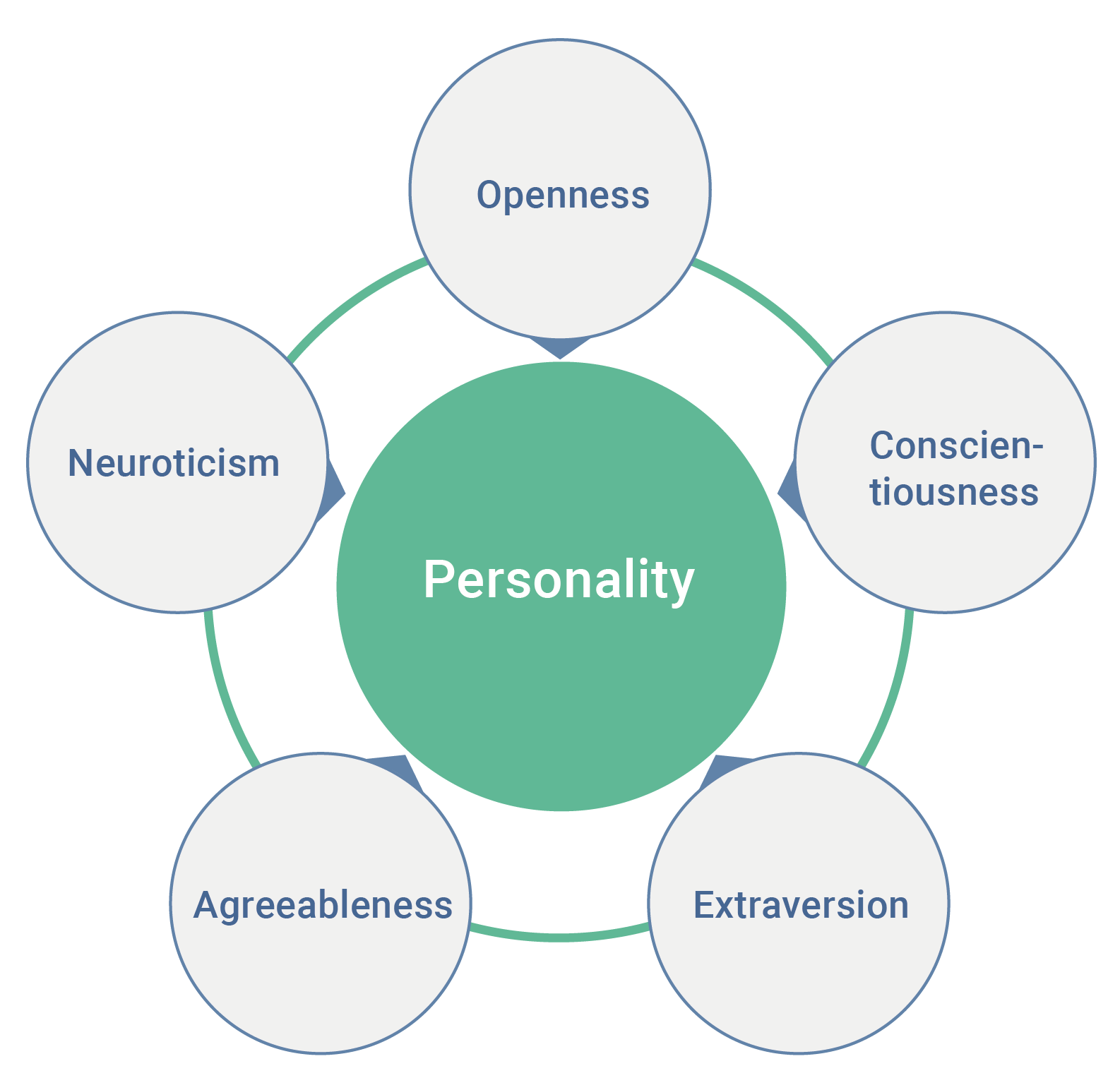 These five traits, unlike the past few types of personality tests, should be memorized. Use the mnemonic device "OCEAN" to help.
These five traits, unlike the past few types of personality tests, should be memorized. Use the mnemonic device "OCEAN" to help.
Comparing Personality Theories
To compare the personality theories you learned in the past few key topics, here is a nice table:
Personality Theory | Key Proponents | Assumptions | View of Personality |
Psychoanalytic | Freud | Emotional disorders spring from unconscious dynamics, such as unresolved sexual and other childhood conflicts, and fixation at various developmental stages. Defense mechanisms fend off anxiety. | Personality consists of pleasure-seeking impulses (the id), a reality-oriented executive (the ego), and an internalized set of ideals (the superego) |
Psychodynamic | Adler, Horney, Jung | The unconscious and conscious minds interact. Childhood experiences and defense mechanisms are important. | The dynamic interplay of conscious and unconscious motives and conflicts shape our personality. |
Humanistic | Rogers, Maslow | Rather than examining the struggles of sick people, it's better to focus on the ways healthy people strive for self-realization. | If our basic human needs are met, people will strive toward self-actualization. In a climate of unconditional positive regard, we can develop self-awareness and a more realistic and positive self-concept. |
Trait | Allport, Eysenck, McCrae, Costa | We have certain stable and enduring characteristics, influenced by genetic predispositions. | Scientific study of traits has isolated important dimensions of personality, such as the Big Five traits. |
Social-Cognitive | Bandura | Our traits and the social context interact to produce our behaviors. | Conditioning and observational learning interact with cognition to create behavior patterns. |
7.10 Measuring Personality
A psychologist’s methods of measuring people’s personalities differ depending on the theory they believe the most strongly in 💭
Direct Observation
This is the classic sit-on-a-park-bench-and-watch-people-interact type assessment. It's basically people-watching. Behaviorists prefer this assessment technique. Behavioral assessments then record the frequency of a specific behavior during an observation. This is usually criticized of being highly subjective, but it does lend a good hand in making inferences about behavior. However, during lab studies, this method can prove to be not so great because of the Hawthorn effect. The Hawthorn effect states that when people know they are being watched, they tend to change their behavior to what they think the observer is expecting. So when using this assessment technique, it's important to use controls.
Projective Tests
Projective tests include asking people to interpret vague, ambiguous stimuli that have more than one meaning. Test-takers reveal inner thoughts that wouldn't have been revealed simply through their interpretation of the stimuli. There are two different types that you should be familiar with:
Rorschach inkblot test is where a psychologist shows people a series of inkblots and asks them to describe what they see. It is the most commonly used projective test, and they aren't really reliable
 The thematic apperception test (TAT) consists of a number of cards that each contain a picture of a person or people in a situation. These are also open to more than one interpretation and participants are asked to tell a story of what is happening in the picture, what led up to it, what people are feeling, etc. to reveal their inner thoughts.
The thematic apperception test (TAT) consists of a number of cards that each contain a picture of a person or people in a situation. These are also open to more than one interpretation and participants are asked to tell a story of what is happening in the picture, what led up to it, what people are feeling, etc. to reveal their inner thoughts.
Personality Inventories
Self-report inventories, or personality inventories, are questionnaires that ask people to provide information about themselves. There are so many different traits that could be gathered from these questionnaires, and psychologists created different versions of them.
One main personality inventory test you should know is the minnesota multiphasic personality inventory(MMPI). It is the most widely used self-report instrument that has lie detector questions built into the inventory to prevent deception and social desirability. It is used in just about any realm of personality and our everyday lives that you could think of.
Overview of Research Methods
Research Method | Description | Perspectives that use this method | Benefits | Weaknesses |
Case study | In-depth study of one individual. | Psychoanalytic, humanistic | Less expensive than other methods. | May not generalize to the larger population. |
Survey | Systematic questioning of a random sample of the population. | Trait, social-cognitive, positive psychology | Results tend to be reliable and can be generalized to the larger population. | May be expensive; correlational findings. |
Projective tests | Ambiguous stimuli designed to trigger projection of inner dynamics. | Psychodynamic | Designed to get beneath the conscious surface of a person's self-understanding; may be a good ice-breaker. | Results have weak validity and reliability. |
Personality inventories | Objectively scored groups of questions designed to identify personality dispositions | Trait | Generally reliable and empirically validated. | Explore limited number of traits. |
Observation | Studying how individuals react in different situations. | Social-cognitive | Allows researchers to study the effects of environmental factors on the way an individual's personality is expressed. | Results may not apply to the larger population. |
Experimentation | Manipulate variables, with random assignment to conditions. | Social-cognitive | Discerns cause and effect. | Some variables cannot feasibly or ethically be manipulate |
 Knowt
Knowt